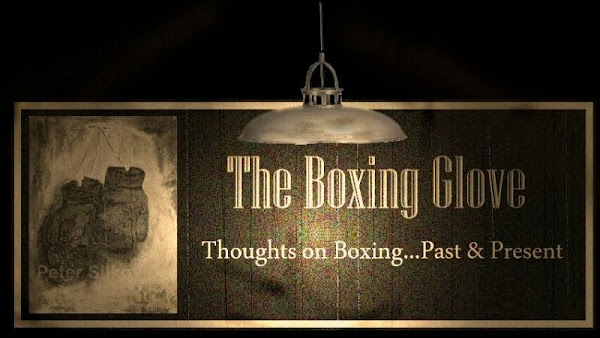By Peter Silkov
Kid
Charol, which translates as Patent Leather Kid, is a legendary figure
in Cuban boxing history, and regarded as Cuba’s first boxing star.
Born, Esteban Gallard, on January 11, 1901, in Sagua La Grande, Cuba.
The
popularity of boxing exploded in Cuba after Jack Johnson’s
ill-fated defence of his World heavyweight championship against
‘white hope’ Jess Williard in Havana, on April 5th,
1915. While the fight with Willard ended in a disastrous (and
controversial) defeat for Johnson, along with the loss of his world
title, the event itself caused a feverish breakout in popularity for
boxing amongst the Cubans, especially amongst the young men who
suddenly saw a way to escape from the poverty in which most of them
lived.
Little
is known about Kid Charol’s early years, but he would have been 14
years old when Johnson fought Willard in Havana, and it's not hard to
imagine that, like many other Cuban men, he was inspired to take up
the sport after seeing all the publicity that surrounded the build up
and aftermath of the Johnson vs Willard match, especially when seeing
how a coloured man like Johnson could lift himself up to riches and
fame through boxing.
It
is not known precisely when Charol had his first fight, and it is
likely that he took part in at least some of the ‘semi-professional’ contests which became so popular in Cuba at that
time. His first appearance as a professional in a verified contest
was in 1922, and his talent was clear from the beginning. Charol was
soon generating rave reviews from anyone who saw him fight. Fighting
as a welterweight, and later a middleweight, Charol had the kind of
talent that allowed him to do anything in the ring. He was an all-round boxer, with strong technique, speed and punching power. In many
ways, the kind of prototype that would be used as a model for so many
of the Cuban greats in the years to come.
Charol’s
actual professional career was relatively short, lasting just seven
years, due to his tragically early death. Yet he fitted in a lot of
fighting in those seven years, although despite many invitations,
Charol never fought in America. Instead he stayed in Cuba and South
America, becoming a huge draw wherever he fought. On March 15, 1924,
Charol won the Cuban middleweight title, by knocking out Rafael Fello
Rodriguez in the 5th round. Charol would never lose this
title in the ring, and was soon regarded as untouchable amongst his
fellow Cuban middleweights.
Charol's
ability was such that he soon had to take on light-heavyweights in
order to stay active, as many fighters were not inclined to meet him
in the ring.
 |
| Kid Charol pictured with Kid Tunero (right) |
The
names on Charol’s record included Enrique Ponce De Leon, Kid
Campilo, Clemente Sanchez, Rafael Fello Rodriguez, Jimmy Finley,
Homer Robertson, Bearcat Reid, Alex Rely, Peter Sung, Larry Estridge,
Ricardo Alis, Panama Joe Gans, Alberto Icochea, Luis Galtieri, Mario
Bosisio, Michele Bonaglia, Ko Brissett, and Dave Shade.
Despite
his ability, Charol never got to fight for a world title. This is
undoubtedly at least partly due to the racial atmosphere of the
times, when coloured fighters were often avoided by the world's top
contenders and champions (who were often white.) The fact that Charol
was so good was also a reason why many of the world's best never
faced him. At the same time, Charol didn’t help his cause by
refusing to travel to America to fight. Yet perhaps his
disinclination to go to America was down to the racial atmosphere
that he would certainly be aware existed there at the time.
Indeed
why would Charol want to go to America when he was already a hero in
Cuba and all around South America. Eventually Charol moved to
Argentina to live, where he became an adopted hero with the Argentine
fight fans.
Unfortunately,
Charol's health started to fail by 1926, when he was still barely at
his athletic peak. Possibly exacerbated by his love of the nightlife,
and burning the candle of life at both ends, Charol had contracted
tuberculosis.
With
the brave stubbornness of a fighter, Charol continued to fight even
as his condition worsened. Before his last fight, against the
brilliant Dave Shade on April 30, 1929, Charol had to drag himself
up from a hospital bed. Yet he still managed to secure a 12-round
draw with a man whom many at the time regarded as being the uncrowned
middleweight champion of the world.
 |
| Kid Charol II at the grave of Kid Charol |
This
was Charol’s final appearance in the ring. He died less than 5
months later, on October 7, 1929, three months before his 29th
birthday.
Despite
his early death, and abbreviated career, Charol would inspire a
generation of future Cuban boxers, including Black Bill, Kid
Chocolate and Charol’s own protégé, Ramon Castillo ‘The Cuban
Baron’.
Charol’s
final verified record was (53-3-10, 34koes) he was only beaten three
times during his professional career, and was never stopped.
If you are an boxer, amateur or professional, and want us to follow you or tell your story, contact petersilkov@yahoo.com or theboxingglove@yahoo.com




























